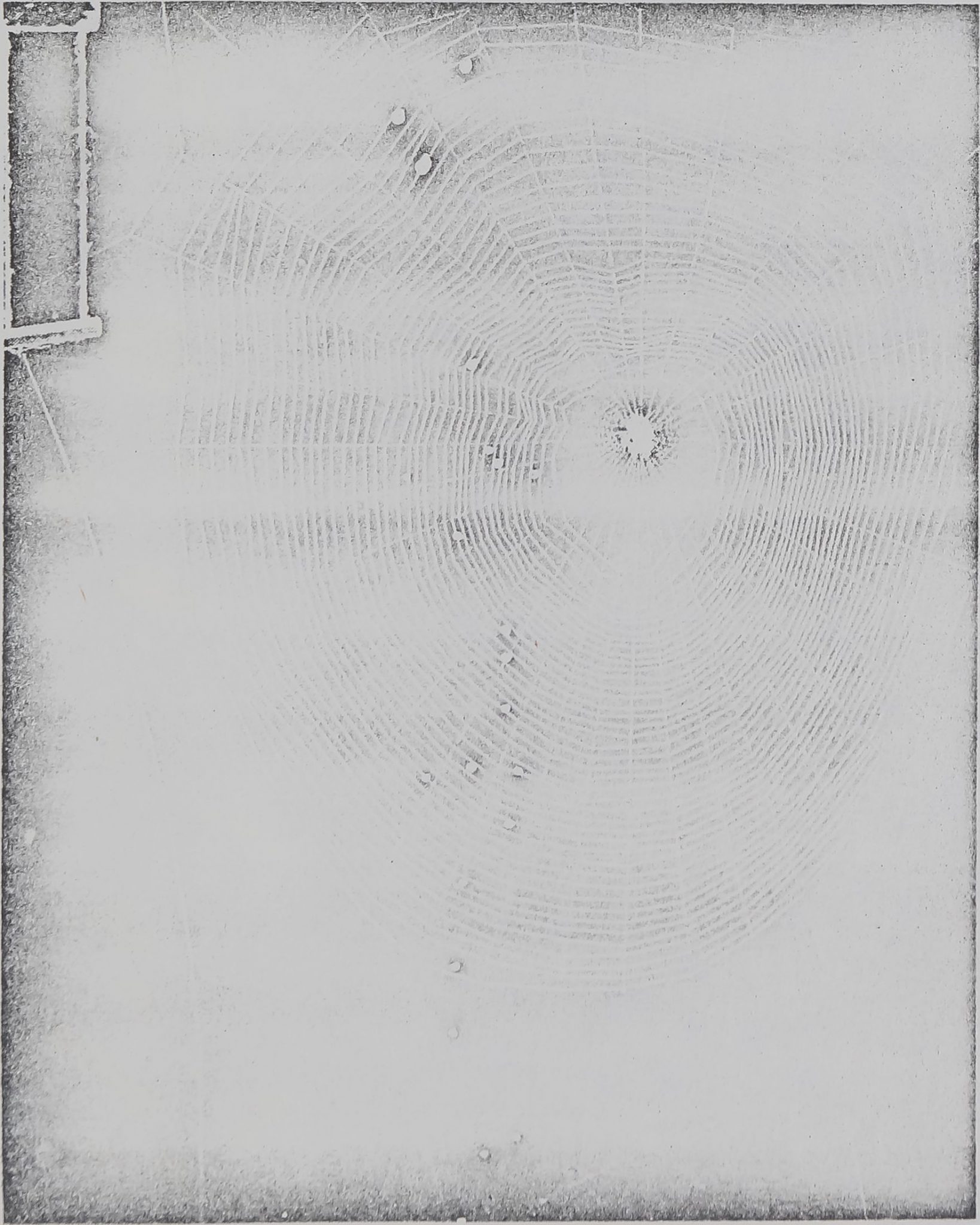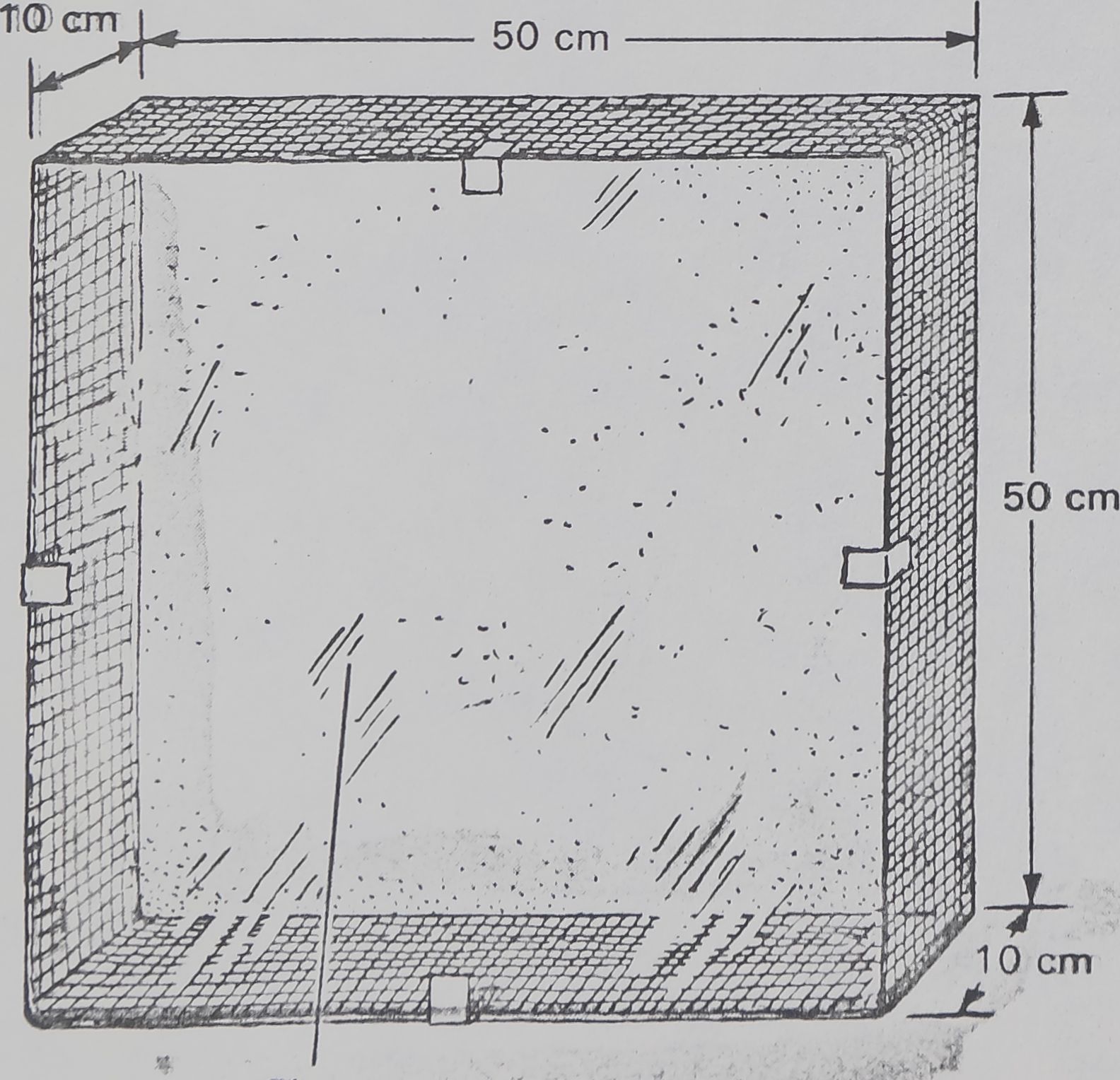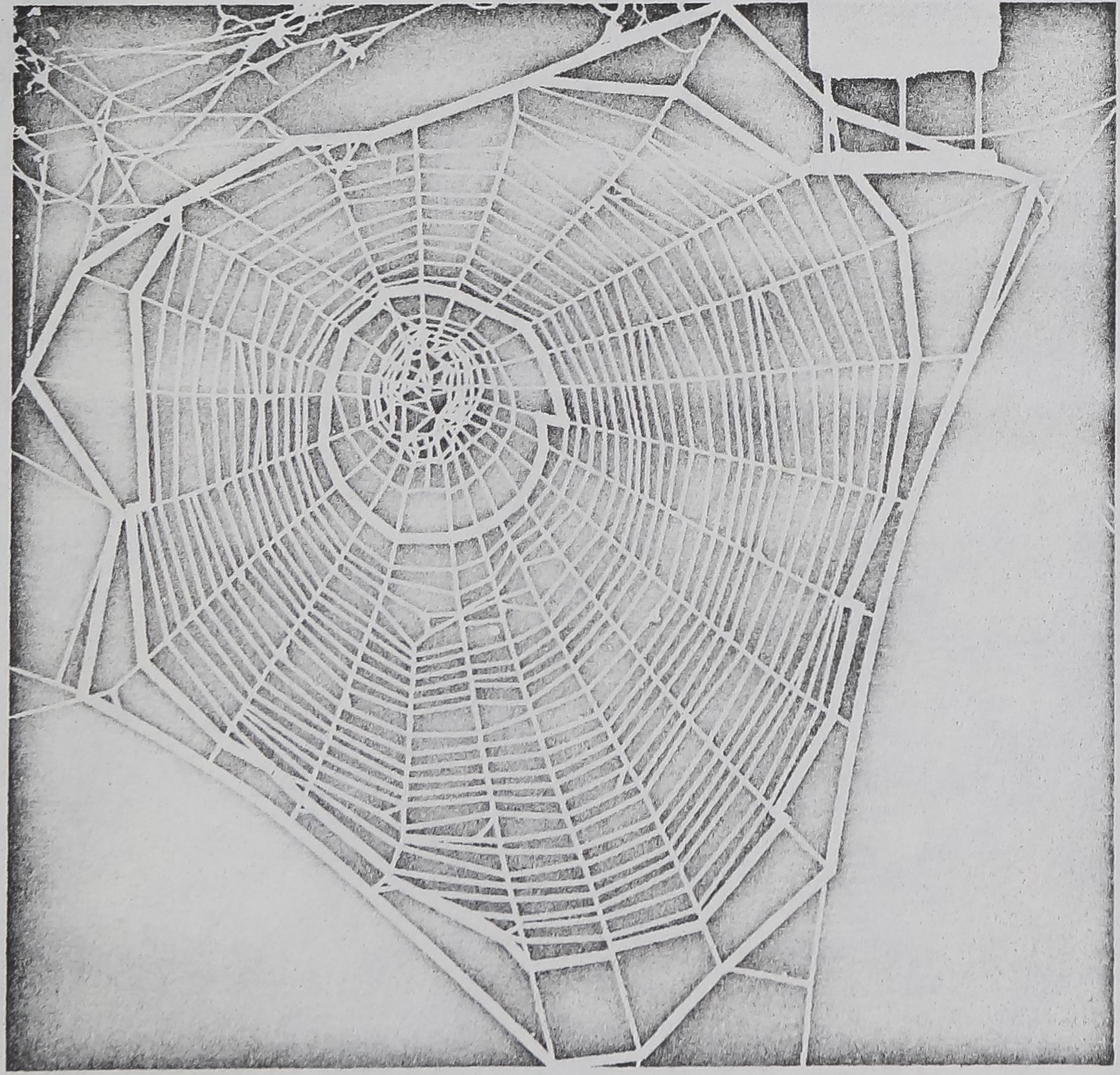Images Collection
View this article in Search Friendly Plain Text
NOTE: This plain text article interpretation has been digitally created by OCR software to estimate the article text, to help both users and search engines find relevant article content. To read the actual article text, view or download the PDF above.
Animal Behavior in Laboratory and Field
Edward 0. Price & Allen W. Stokes (eds.)
W. H. Freeman & Co,, 1975.
PETER N. WITT
North Carolina Department of Mental Health
V Raleigh, N.C.
Web Construction in Spiders
The orb web of a spider (Fig. 34.1) is the outcome of
highly complex and stereotyped behavioral patterns,
Figure 34-1. Web of adult female Araneus diadematus Cl.
built in an aluminum frame in the laboratory, and photo-
graphed against a black box with lights shining from four
sides. Note spider as white figure in center of web, and scale
of two vertical white lines, 20 mm apart, in upper left corner.
and has a key role in the survival of the organism.
It constitutes a trap in which flying prey is caught,
it extends the perceptual range of a nearly blind
organism, and the threads provide the substrate on
which hooked legs can move at high speed. The pur-
pose of this exercise is to demonstrate some of thé
factors that determine web location, the sequence of
events that results in web construction, and the ex-
tent to which web construction may be modified.
METHODS
Subjects and Materials
For indoor observation you will need a frame to
house the spider and provide an anchor for its web,
a room in which light and temperature can be ma-
nipulated, a good light, and a dark background for
observation and possibly photography. A simple
frame can be made of four rectangular pieces of
cardboard, 10 X 50 cm, taped together to form a
square; transparent wrap can be used to close front
and back. Figure 34.2 shows a more permanent
frame that can be constructed from wood or metal.
The screens on the narrow sides of the frame facili*
tate anchoring for frame threads, and the glass doors
prevent escape and permit a clear view of the web;
glass should be removed for photography. Web*
building indoors is more likely under conditions of
(a) high humidity, achieved by placing open vessels
filled with water around the frame, (b) short (8-hour)
nights, produced in winter by turning on electric
lights m the evening and morning, and (c) a tem-
jroa&ure difference of at least 5°C between night
and day, obtained by changing the thermostat setting
<air (lulling windows. More details are given in Witt
iWIil)) aamd Witt et al. (1968).
Procedure
A. Time and Place of Web Building Since most
sgiidlers in the field build their webs eveiy morning
aftsumrise,. observations on the beginning and ending
tf w^^uildmg can be most profitably made at this
tdimfiL If the exercise takes place in the late summer,
yown will find many webs built close together,, and you
earn gain some knowledge of a species’ site prefer-
ences* by determining the height of the web from the
gBOunid and the direction that it faces as well as by
necoiiding the supporting plants. The effect of wind
wefo site selection can be tested by constructing
wind shields or placing plastic cylinders outdoors
and watching the consequent web locations, or re-
tesraog animals indoors in a space that contains
Bapiidiÿ moving as well as quiet air spaces (Enders,
W7/Z)i Additional observations on web height can be
made by releasing spiders of different species in a
room with a high ceiling. Certain species may build
their webs closer to the ceiling than others. (Data on
web height can be statistically analyzed for species
differences.) For further reading on timing and fre-
Ggujeney of web building and on web location see
Witt (1963) and Turnbull (1973).
Figure^ Sketch of wooden or aluminum box ^pr keeping
a single web-building spider in the laboratory.
Web Construction in Spiders 115
B. Web-Building Behavior Since the timing of
web building indoors is often unpredictable, the
observer may be well rewarded for staying up one
night with 3-5 spiders. Best results are obtained by
using young females of a species that builds a web
daily, e.g.y Araneus diadematus Cl. (See also Witt,
1971.) Observe the web-building process from be-
ginning to end.
1. How many phases can you recognize during
construction of one web?
2. What characteristic pattern of movements is
repeated over and over in a phase?
3. Which principal role do the front legs play in
web building? Which do the hind-legs play?
4. What is the last movement of the spider when it
finishes a web?
5. How much does a spider use its weight in web
construction, and how do you think weightlessness
would interfere with web building?
Once you have learned the normal sequence of
events in web construction tiy some experimental
manipulations as new webs are being built. For ex-
ample, what is the effect of repeatedly cutting a
radius just after it is laid? How many times will the
spider rebuild a radius in the same place? Does the
spider’s response to this experimental manipulation
depend on the stage of web construction at the time?
What is the consequence of transferring spiders in
the middle of construction from their own to another
structure?
Through these observations you can learn a great
deal1 about the plasticity of web-building behavior,
the way it is “coded” in the animal, and how it serves
the survival of the species. (See also Peters, 1970;
Reed; 1969.)
C. The Physical Web and Its Behavioral Correlates
Only after we have established objective, quantita-
tive measures of behavior can we begin to identify
factors that influence the physical structure of the
web itself. Simple web measures can be obtained by
measuring the vertical and horizontal diameter of
the catching area with a ruler and by counting the
number of radii and spiral turns; size of catching
area divided by number of radii plus number of
spiral turns provides a figure for mean mesh size.
For exact measurements, webs should be photo-
graphed. You can use pictures taken in the field,
hut. for analysis of pattern, you generally get better
photographs if the web is built in a laboratory frame.
For further information on web photography see
Witt (1971).
116 Part Three — Field Studies
A planimeter can be used to measure central,
catchir\g, and frame zones of the web separately
(Fig. 34.3). These measurements may show some
relation to other parameters of importance to the
survival of spiders (e.g., abundance of food, size and
species of spider). Regularity measures have been
shown to be most affected by age and drugs; mea-
sures of regularity can be obtained from radial angles
as well as spiral distances. If you lay a ruler and pro-
tractor over a photograph of a web, centering the
protractor on the web center, the central angles of
radii can easily be recorded. By subtracting neigh-
boring angles from each other (e.g., 18° — 16° = 2°;
16° S 17° ‘= 1°, . . .) and calculating the mean of
all such differences, you obtain a single figure for the
angular regularity of a web. Another group of inter-
esting measures identifies the shape (i.e., length over
width of catching area). For more explanations of
web measures, how they are taken and when they
deviate from, normal, consult Witt et al. (1968). After
obtaining measures for several webs of a single
spider, you may want to investigate the role which
the absence of a leg plays in the achievement of web
geometry. It would be surprising to find that an
Figure 34-3. Thick white lines outline (from the center) the
spiral turn enclosing the center area; the utermost spiral
turn, enclosing the spiral or catching area; and the frame of
the web of an adult female spider. The three areas, which can
be measured with a planimeter, show sizes and ratios to each
other that are characteristic of the species, age, and state of
the builder.
occurrence as common as the loss of a single leg
made spiders incapable of weaving a trap for prey.
Legs can’substitute in function for each other, and
only a multiple loss will result in abnormal web
construction. Each pair of legs has a different func-
tion (e.g., first pair, probing; last pair, thread laying)
and the removal of a pair will show disturbances in
web geometry related to that pair’s task. New obser-
vations may contribute to the analysis of the role
which each leg or leg combination plays in thread
positioning (see Reed et ah, 1965).
QUESTIONS
1. Is there a species or age difference for: (a) mean
distance between hub and ground in orb webs? (b)
vegetation on which webs are attached? (c) mean
mesh width and size of center area?
2. Is frequency of web renewal dependent on:
{a) destruction of old web? (b) amount of prey eaten?
■(c) species of spider? (d) time of removal of old web?
3. List separately parts of web-building behavior
or web use which can or cannot be modified by
changes in the environment.
4. What factors (biochemical, behavioral) might-
cause a spider to build a smaller web than normally
expected? Design an experiment * to determine
whether a relatively small web was the result of a
lack of silk supply at web-building time.
ADDITIONAL STUDIES
You may want to explore a little further the “world
of touch” in which a spider lives. With a vibrating
tuning fork held to a radius, questions can be ex-
plored like range of perception, threshold intensity,
and type of habituation which occurs to repeated
stimulation of one or several radii. In prey catching,
there is a chain of stimulus-reaction sequences to
be observed, from the first impact of the fly against
the web to the final sucking out of prey (Robinson
and Olazarri, 1971). What stimulus releases what
reaction? Are there alternate pathways? Do the
spider’s age and/or body weight as well as hunger
play a role in the hunter-prey interaction? There are
many such problems open to the interested investiga-
tor with access to a small colony of web-building
spiders.
Web Construction in Spiders 117
REFERENCES
Enders, F., 1973. Selection of habitat by the spider
Argiope aurantia Lucas (Araneidae). Amer. Mid-
land. Natur. 90:47-55.
Gertsch, W. I., 1964. American spiders. New York:
Van Nostrand.
Kaston, B. S., and E. Kaston, 1953. How to know the
spiders. Dubuque, Iowa: W. C. Brown.
Levi, H. W., L. R. Levi, and H. S. Zim, 1968. A guide
to spiders and their kin. New York: Golden Press.
Peters, P., 1970. Orb web construction: interaction of
spider ( Araneus diadematus Cl.) and thread con-
figuration. Anim. Behav. 18:478-484.
Reed, C. F., 1969. Cues in the web-building process.
Amer. Zool. 9:211-221.
Reed, C. F., P. N. Witt, and R. L. Jones, 1965. The
measuring function of the first legs of Araneus
diadematus Cl. Behaviour 24:98-119.
Robinson, M. H., and J. Olazarri, 1971. Units of
behavior and complex sequences in the preda-
tory behavior of Argiope argentata. Smithsonian
Contrib. Zool 65:1-36.
Turnbull, A. L., 1973. Ecology of the true spiders.
Annu. Rev. Entomol. 18:305-348.
Witt, P. N., 1973. Environment in relation to be-
havior of spiders. Arch. Environ. Health 7:4-12.
Witt, P. N., 1971. Instructions for working with web-
building spiders in the laboratory. BioScience
21:23-25.
Witt, P. N., C. F. Reed, and D. B. Peakall, 1968. A
spider’s web. Problems in regulatory biology.
New York: Springer.
Witt, P. N., and L. Salzmann, 1973. Life on a thread’
an introduction into the study of behavior (20-
minute, 16-mm film). Philadelphia: Blue Flower
Films.
V
Use them for helping move birds in and out of the observation pens.
If the birds in the adjacent pen appear to be unduly in-
fluencing the behavior of the birds under observation, they should
be removed and placed temporarily in a poultry crate or similar
container out of sight and preferably hearing.
This exercise may be run purely qualitatively to demonstrate
the various behavior patterns and calls of chickens and their
association with dominance and subordinance? and to demonstrate
the phenomenon of social hierarchy. The exercise can also be con-
ducted more rigorously in an attempt to quantify the frequency and
sequences of behavior components in relation to dominance and sub-
ordinance, and to the sex of the birds. If the latter procedure
is followed, the first period should be used to allow the students.
to identify and describe the behavior components? the second
period to quantify them.
Coturnix quail may be substituted for chickens in this
exercise (see Exercise 22)^ ^
EXERCISE 34. WEB CONSTRUCTION IN SPIDERS
You may want to make sure in advance that the necessary
spiders for the exercise are available. From late spring to late
autumn orb-webs can be found outdoors, frequently a great number in
the same area. In the early morning and at sunset spiders sit in
the hub of the web, and the low sun and dew make threads relatively
well recognizable, while it is difficult to see a web or find a
“‘spider in the middle of the day.
53
One source of web-building spiders (available at all times
except late winter and early spring) is Mr. Leonard Pankhurst#
204 Stroud Street, Canastota# New ork. If time permits# one can
search for or order a cocoon# and watch the hatching spiderlings#
which will start building about two weeks after leaving the egg
shell.
As long as spiders are given water (sprayed on the webs or
through a drop placed on the mouth parts) # they survive in the
laboratory for several weeks.
A web photograph can be made in advance# duplicated# and given
to students in the laboratory for evaluation. Several small groups
can compare size, shape# and regularity measures obtained from the
same web. The task of measuring a web proves to be a special
opportunity to become familiar with details of the web pattern.
EXERCISE 35. TERRITORIAL BEHAVIOR IN DRAGONFLIES
■
Before taking the class into the field# the instructor should
discuss with students territoriality and the criteria for determin-
ing whether an animal is displaying territorial behavior. The
instructor should also briefly discuss the natural history of
dragonflies so that students may be alert for observing all
aspects of their life cycle.
After mating (described in the exercise), eggs of dragonflies
are deposited either by the female repeatedly dipping her abdomen
as she hovers low over water or# in some species# by inserting
eggs into aquatic vegetation by means of a special ovipositor as
54


